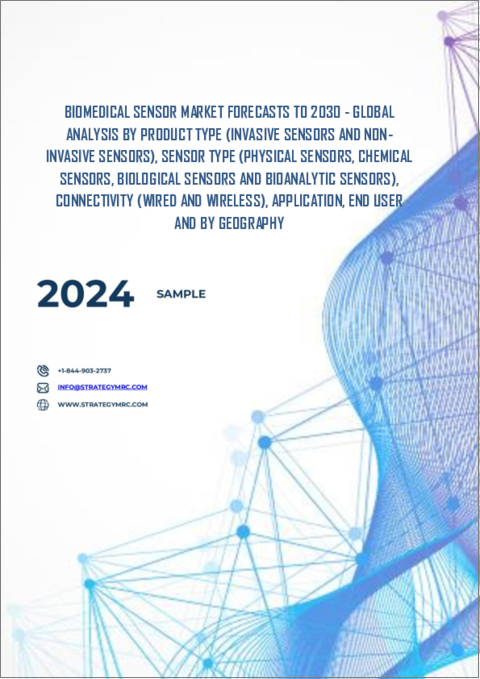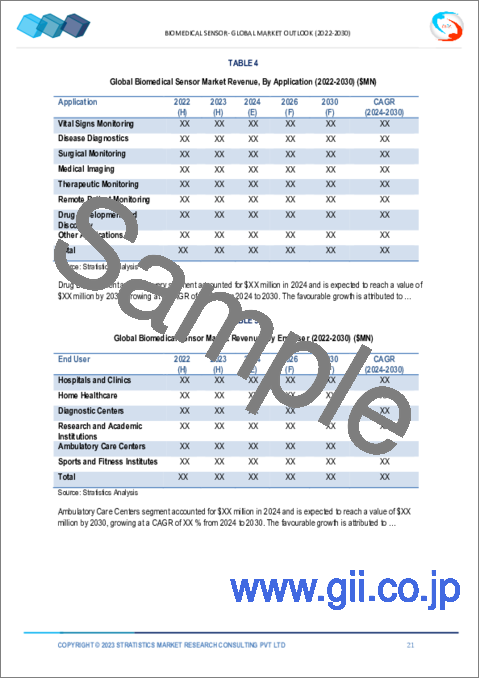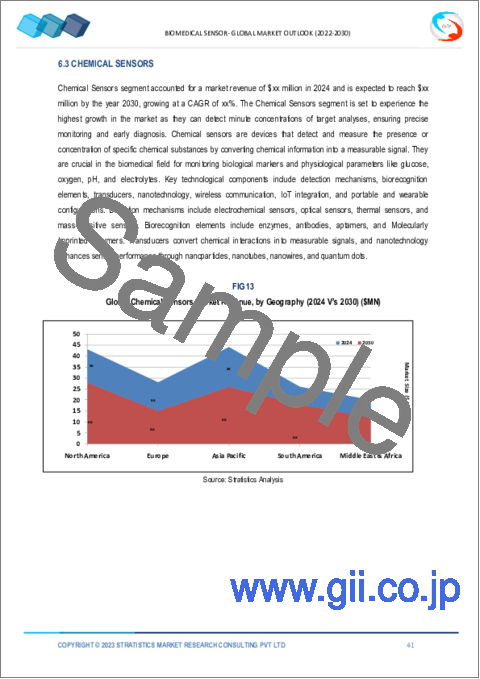|
|
市場調査レポート
商品コード
1603798
バイオメディカルセンサの世界市場予測(~2030年): 製品タイプ、センサタイプ、接続性、用途、エンドユーザー、地域別の分析Biomedical Sensor Market Forecasts to 2030 - Global Analysis By Product Type, Sensor Type, Connectivity, Application, End User and By Geography |
||||||
カスタマイズ可能
|
|||||||
| バイオメディカルセンサの世界市場予測(~2030年): 製品タイプ、センサタイプ、接続性、用途、エンドユーザー、地域別の分析 |
|
出版日: 2024年11月11日
発行: Stratistics Market Research Consulting
ページ情報: 英文 200+ Pages
納期: 2~3営業日
|
- 全表示
- 概要
- 図表
- 目次
Stratistics MRCによると、世界のバイオメディカルセンサの市場規模は、2024年に107億米ドルを占め、予測期間中のCAGRは8.8%で成長し、2030年には178億米ドルに達すると予測されています。
バイオメディカルセンサは、体温、血圧、心拍数、グルコースレベルなどの生体信号やパラメーターを検出・測定することで、人の健康をモニターするために使用されるデバイスです。これらのセンサは、生理学的データを分析用の電気信号に変換することで、病気の診断、治療モニタリング、患者のケアに役立ちます。ウェアラブル技術、診断ツール、医療用インプラントはすべて、リアルタイムの健康監視を提供し、より良い結果を得るためのオーダーメイドの医療介入を可能にするために、バイオメディカルセンサを使用しています。
世界保健機関(WHO)によると、心血管疾患や糖尿病などの慢性疾患は、2021年に世界で約5億3,700万人の成人に影響を及ぼしました。
患者モニタリングの需要増加
慢性疾患の蔓延と高齢化により、患者モニタリングシステムの需要が増加しています。バイオメディカルセンサは、バイタルサインやその他の健康パラメータの継続的なリアルタイムモニタリングを可能にし、健康問題の早期発見とタイムリーな介入を可能にします。この動向は、ヘルスケア環境や在宅ケア環境におけるバイオメディカルセンサの採用を促進し、市場の成長を後押ししています。
セキュリティへの懸念
バイオメディカルセンサと接続機器やネットワークが統合されると、データセキュリティや患者のプライバシーに関する懸念が生じます。機密性の高い医療情報への不正アクセスは、守秘義務違反やデータの悪用につながる可能性があります。このようなセキュリティリスクは、特にヘルスケア機関やプライバシー意識の高い個人の間で、バイオメディカルセンサの普及を妨げる可能性があり、市場の成長を抑制します。
ヘルスケア支出の増加
世界のヘルスケア支出の増加は、バイオメディカルセンサ市場にとって大きなチャンスです。政府や民間部門がヘルスケアインフラや先進医療技術への投資を増やすにつれて、バイオメディカルセンサを組み込んだ高度なモニタリング・診断ツールの需要が高まると予想されます。この動向は、ヘルスケアシステムの近代化が急速に進む新興国で特に顕著です。
ヘルスケア規制の変化
バイオメディカルセンサ市場は、ヘルスケア規制や基準の進化による潜在的な脅威に直面しています。センサを含む医療機器に対する厳しい規制要件は、製品開発サイクルの長期化とコスト増につながる可能性があります。さらに、償還政策の変更は、ヘルスケア環境におけるセンサベース技術の採用に影響を与える可能性があります。こうした規制上の不確実性は、市場関係者に課題をもたらし、成長軌道に影響を与える可能性があります。
COVID-19の影響:
COVID-19パンデミックはバイオメディカルセンサ市場に大きな影響を与えました。当初、サプライチェーンの混乱と製造の停滞が一時的な後退を引き起こしました。しかし、パンデミックは遠隔患者モニタリングソリューションと遠隔医療サービスの採用を加速させ、バイオメディカルセンサの需要を促進しました。病院や在宅介護の現場で患者のバイタルサインを継続的に監視する必要性が、市場の成長をさらに押し上げました。長期的な効果としては、個人の健康モニタリングに対する意識の高まりや予防ヘルスケアへのシフトが挙げられ、バイオメディカルセンサ市場に利益をもたらしています。
予測期間中、非侵襲性センサセグメントが最大になる見込み
非侵襲性センサセグメントは、患者の快適性と使いやすさに優れているため、予測期間を通じて最大の市場シェアを確保すると予測されています。これらのセンサは、皮膚を破ったり体腔に入ったりすることなく様々な生理学的パラメータをモニタリングできるため、連続モニタリングや在宅ヘルスケア用途に最適です。非侵襲性センサはまた、侵襲的な代替品と比較して感染や合併症のリスクを低減します。低侵襲医療処置への嗜好の高まりとウェアラブル健康機器の採用増加が、このセグメントの優位性に寄与しています。
予測期間中、バイオ分析センサセグメントのCAGRが最も高くなる見込み
バイオ分析センサセグメントは、予測期間中に大幅な成長が見込まれます。これらのセンサは、体内の特定の生物学的または化学的物質を検出・測定するように設計されており、高い感度と選択性を提供します。個別化医療、ポイントオブケア診断、様々な疾患のバイオマーカーの継続的モニタリングへの注目の高まりが、バイオ分析センサの需要を牽引しています。さらに、ナノテクノロジーと材料科学の進歩により、これらのセンサの機能が強化され、複雑な生物学的サンプルの迅速、正確かつコスト効率の高い分析が可能となっています。
最大のシェアを占める地域:
予測期間中、北米がバイオメディカルセンサ市場で最大のシェアを占めると予想されています。この優位性は、高度なヘルスケアインフラ、高い医療費、革新的医療技術の早期導入など、いくつかの要因によるものです。この地域には大手医療機器メーカーや研究機関が多く存在し、センサ技術の継続的な革新に貢献しています。さらに、慢性疾患の有病率の高さと人口の高齢化が、バイオメディカルセンサを組み込んだ高度な患者モニタリングソリューションの需要を促進しています。
CAGRが最も高い地域:
アジア太平洋は、バイオメディカルセンサ市場で最も高いCAGRを達成すると予測されています。中国やインドなどの国々における急速な経済成長、医療支出の増加、医療インフラの改善が市場拡大の原動力となっています。この地域の人口の多さと増加、予防ヘルスケアに対する意識の高まりが、バイオメディカルセンサの大きな市場を形成しています。さらに、ヘルスケアシステムの近代化を目指す政府の取り組みや、デジタルヘルス技術の採用増加も、この地域の市場成長率の高さに貢献しています。
無料のカスタマイズサービス
本レポートをご購読のお客様には、以下の無料カスタマイズオプションのいずれかをご利用いただけます:
- 企業プロファイル
- 追加市場企業の包括的プロファイリング(3社まで)
- 主要企業のSWOT分析(3社まで)
- 地域セグメンテーション
- 顧客の関心に応じた主要国の市場推計・予測・CAGR(注:フィージビリティチェックによる)
- 競合ベンチマーキング
- 製品ポートフォリオ、地理的プレゼンス、戦略的提携に基づく主要企業のベンチマーキング
目次
第1章 エグゼクティブサマリー
第2章 序文
- 概要
- ステークホルダー
- 調査範囲
- 調査手法
- データマイニング
- データ分析
- データ検証
- 調査アプローチ
- 調査情報源
- 1次調査情報源
- 2次調査情報源
- 前提条件
第3章 市場動向分析
- 促進要因
- 抑制要因
- 機会
- 脅威
- 製品分析
- 用途分析
- エンドユーザー分析
- 新興市場
- COVID-19の影響
第4章 ポーターのファイブフォース分析
- 供給企業の交渉力
- 買い手の交渉力
- 代替品の脅威
- 新規参入業者の脅威
- 競争企業間の敵対関係
第5章 世界のバイオメディカルセンサ市場:製品タイプ別
- 侵襲性センサ
- 非侵襲性センサ
第6章 世界のバイオメディカルセンサ市場:センサタイプ別
- 物理センサ
- 機械式
- 油圧式
- 幾何学的
- 電気
- サーマル
- 光学
- 化学センサ
- ガス
- 測光
- 電気化学
- その他の化学センサ
- バイオセンサ
- 体表面生体電位電極
- 腔内および組織内電極
- 金属板
- 微小電極
- バイオ分析センサ
- 酵素
- タンパク質
- 抗原
- 抗体
- リガンド
- 細胞
- DNA
第7章 世界のバイオメディカルセンサ市場:接続性別
- 有線
- 無線
第8章 世界のバイオメディカルセンサ市場:用途別
- バイタルサインモニタリング
- 病気の診断
- 外科的モニタリング
- 医療画像
- 治療モニタリング
- 遠隔患者モニタリング
- 医薬品の開発・創薬
- その他の用途
第9章 世界のバイオメディカルセンサ市場:エンドユーザー別
- 病院と診療所
- 在宅医療
- 診断センター
- 研究・学術機関
- 外来診療センター
- スポーツとフィットネス施設
第10章 世界のバイオメディカルセンサ市場:地域別
- 北米
- 米国
- カナダ
- メキシコ
- 欧州
- ドイツ
- 英国
- イタリア
- フランス
- スペイン
- その他欧州
- アジア太平洋
- 日本
- 中国
- インド
- オーストラリア
- ニュージーランド
- 韓国
- その他アジア太平洋
- 南米
- アルゼンチン
- ブラジル
- チリ
- その他南米
- 中東・アフリカ
- サウジアラビア
- アラブ首長国連邦
- カタール
- 南アフリカ
- その他中東・アフリカ
第11章 主な発展
- 契約、パートナーシップ、コラボレーション、合弁事業
- 買収と合併
- 新製品発売
- 事業拡大
- その他の主要戦略
第12章 企業プロファイリング
- GE Healthcare
- Analog Devices, Inc.
- STMicroelectronics N.V.
- Medtronic PLC
- NXP Semiconductor N.V.
- Honeywell International Inc.
- Texas Instruments
- Nonin Medical Inc.
- First Sensor AG
- Smiths Medical
- Measurement Specialties, Inc.
- LumaSense Technologies
- Zephyr Technology Corp.
- Innovative Sensor Technology USA
- Amphenol Corporation
List of Tables
- Table 1 Global Biomedical Sensor Market Outlook, By Region (2022-2030) ($MN)
- Table 2 Global Biomedical Sensor Market Outlook, By Product Type (2022-2030) ($MN)
- Table 3 Global Biomedical Sensor Market Outlook, By Invasive Sensors (2022-2030) ($MN)
- Table 4 Global Biomedical Sensor Market Outlook, By Non-Invasive Sensors (2022-2030) ($MN)
- Table 5 Global Biomedical Sensor Market Outlook, By Sensor Type (2022-2030) ($MN)
- Table 6 Global Biomedical Sensor Market Outlook, By Physical Sensors (2022-2030) ($MN)
- Table 7 Global Biomedical Sensor Market Outlook, By Mechanical (2022-2030) ($MN)
- Table 8 Global Biomedical Sensor Market Outlook, By Hydraulic (2022-2030) ($MN)
- Table 9 Global Biomedical Sensor Market Outlook, By Geometric (2022-2030) ($MN)
- Table 10 Global Biomedical Sensor Market Outlook, By Electric (2022-2030) ($MN)
- Table 11 Global Biomedical Sensor Market Outlook, By Thermal (2022-2030) ($MN)
- Table 12 Global Biomedical Sensor Market Outlook, By Optical (2022-2030) ($MN)
- Table 13 Global Biomedical Sensor Market Outlook, By Chemical Sensors (2022-2030) ($MN)
- Table 14 Global Biomedical Sensor Market Outlook, By Gas (2022-2030) ($MN)
- Table 15 Global Biomedical Sensor Market Outlook, By Photometric (2022-2030) ($MN)
- Table 16 Global Biomedical Sensor Market Outlook, By Electrochemical (2022-2030) ($MN)
- Table 17 Global Biomedical Sensor Market Outlook, By Other Chemical Sensors (2022-2030) ($MN)
- Table 18 Global Biomedical Sensor Market Outlook, By Biological Sensors (2022-2030) ($MN)
- Table 19 Global Biomedical Sensor Market Outlook, By Body Surface Biopotential Electrode (2022-2030) ($MN)
- Table 20 Global Biomedical Sensor Market Outlook, By Intracavitary and Intratissue Electrode (2022-2030) ($MN)
- Table 21 Global Biomedical Sensor Market Outlook, By Metal Plate (2022-2030) ($MN)
- Table 22 Global Biomedical Sensor Market Outlook, By Microelectrode (2022-2030) ($MN)
- Table 23 Global Biomedical Sensor Market Outlook, By Bioanalytic Sensors (2022-2030) ($MN)
- Table 24 Global Biomedical Sensor Market Outlook, By Enzymes (2022-2030) ($MN)
- Table 25 Global Biomedical Sensor Market Outlook, By Protein (2022-2030) ($MN)
- Table 26 Global Biomedical Sensor Market Outlook, By Antigen (2022-2030) ($MN)
- Table 27 Global Biomedical Sensor Market Outlook, By Antibody (2022-2030) ($MN)
- Table 28 Global Biomedical Sensor Market Outlook, By Ligand (2022-2030) ($MN)
- Table 29 Global Biomedical Sensor Market Outlook, By Cell (2022-2030) ($MN)
- Table 30 Global Biomedical Sensor Market Outlook, By DNA (2022-2030) ($MN)
- Table 31 Global Biomedical Sensor Market Outlook, By Connectivity (2022-2030) ($MN)
- Table 32 Global Biomedical Sensor Market Outlook, By Wired (2022-2030) ($MN)
- Table 33 Global Biomedical Sensor Market Outlook, By Wireless (2022-2030) ($MN)
- Table 34 Global Biomedical Sensor Market Outlook, By Application (2022-2030) ($MN)
- Table 35 Global Biomedical Sensor Market Outlook, By Vital Signs Monitoring (2022-2030) ($MN)
- Table 36 Global Biomedical Sensor Market Outlook, By Disease Diagnostics (2022-2030) ($MN)
- Table 37 Global Biomedical Sensor Market Outlook, By Surgical Monitoring (2022-2030) ($MN)
- Table 38 Global Biomedical Sensor Market Outlook, By Medical Imaging (2022-2030) ($MN)
- Table 39 Global Biomedical Sensor Market Outlook, By Therapeutic Monitoring (2022-2030) ($MN)
- Table 40 Global Biomedical Sensor Market Outlook, By Remote Patient Monitoring (2022-2030) ($MN)
- Table 41 Global Biomedical Sensor Market Outlook, By Drug Development and Discovery (2022-2030) ($MN)
- Table 42 Global Biomedical Sensor Market Outlook, By Other Applications (2022-2030) ($MN)
- Table 43 Global Biomedical Sensor Market Outlook, By End User (2022-2030) ($MN)
- Table 44 Global Biomedical Sensor Market Outlook, By Hospitals and Clinics (2022-2030) ($MN)
- Table 45 Global Biomedical Sensor Market Outlook, By Home Healthcare (2022-2030) ($MN)
- Table 46 Global Biomedical Sensor Market Outlook, By Diagnostic Centers (2022-2030) ($MN)
- Table 47 Global Biomedical Sensor Market Outlook, By Research and Academic Institutions (2022-2030) ($MN)
- Table 48 Global Biomedical Sensor Market Outlook, By Ambulatory Care Centers (2022-2030) ($MN)
- Table 49 Global Biomedical Sensor Market Outlook, By Sports and Fitness Institutes (2022-2030) ($MN)
Note: Tables for North America, Europe, APAC, South America, and Middle East & Africa Regions are also represented in the same manner as above.
According to Stratistics MRC, the Global Biomedical Sensor Market is accounted for $10.7 billion in 2024 and is expected to reach $17.8 billion by 2030, growing at a CAGR of 8.8% during the forecast period. A biomedical sensor is a device used to monitor a person's health by detecting and measuring biological signals or parameters, such as temperature, blood pressure, heart rate, or glucose levels. These sensors help with disease diagnosis, treatment monitoring, and patient care by converting physiological data into electrical signals for analysis. Wearable technology, diagnostic tools, and medical implants all use biomedical sensors to provide real-time health monitoring and enable tailored medical interventions for better results.
According to the World Health Organization (WHO), chronic diseases such as cardiovascular diseases and diabetes affected approximately 537 million adults globally in 2021.
Market Dynamics:
Driver:
Increased demand for patient monitoring
The growing prevalence of chronic diseases and an aging population have led to increased demand for patient monitoring systems. Biomedical sensors enable continuous, real-time monitoring of vital signs and other health parameters, allowing for early detection of health issues and timely interventions. This trend is driving the adoption of biomedical sensors in healthcare settings and home care environments, fueling market growth.
Restraint:
Security concerns
The integration of biomedical sensors with connected devices and networks raises concerns about data security and patient privacy. Unauthorized access to sensitive health information could lead to breaches of confidentiality and potential misuse of data. These security risks may hinder the widespread adoption of biomedical sensors, particularly in healthcare institutions and among privacy-conscious individuals, thus restraining market growth.
Opportunity:
Growing healthcare expenditure
Increasing healthcare expenditure worldwide presents a significant opportunity for the biomedical sensors market. As governments and private sectors invest more in healthcare infrastructure and advanced medical technologies, the demand for sophisticated monitoring and diagnostic tools incorporating biomedical sensors is expected to rise. This trend is particularly pronounced in emerging economies, where healthcare systems are rapidly modernizing.
Threat:
Changes in healthcare regulations
The biomedical sensors market faces potential threats from evolving healthcare regulations and standards. Stringent regulatory requirements for medical devices, including sensors, can lead to longer product development cycles and increased costs. Additionally, changes in reimbursement policies may affect the adoption of sensor-based technologies in healthcare settings. These regulatory uncertainties could pose challenges to market players and impact growth trajectories.
Covid-19 Impact:
The COVID-19 pandemic significantly impacted the biomedical sensors market. Initially, supply chain disruptions and manufacturing slowdowns caused temporary setbacks. However, the pandemic also accelerated the adoption of remote patient monitoring solutions and telehealth services, driving demand for biomedical sensors. The need for continuous monitoring of COVID-19 patients' vital signs in hospitals and home care settings further boosted market growth. Long-term effects include increased awareness of personal health monitoring and a shift towards preventive healthcare, benefiting the biomedical sensors market.
The non-invasive sensors segment is expected to be the largest during the forecast period
The non-invasive sensors segment is predicted to secure the largest market share throughout the forecast period due to their advantages in patient comfort and ease of use. These sensors can monitor various physiological parameters without breaking the skin or entering body cavities, making them ideal for continuous monitoring and home healthcare applications. Non-invasive sensors also offer reduced risk of infection and complications compared to invasive alternatives. The growing preference for minimally invasive medical procedures and the increasing adoption of wearable health devices contribute to this segment's dominance.
The bioanalytic sensors segment is expected to have the highest CAGR during the forecast period
The bioanalytic sensors segment is projected to witness substantial growth during the projection period. These sensors are designed to detect and measure specific biological or chemical substances in the body, offering high sensitivity and selectivity. The increasing focus on personalized medicine, point-of-care diagnostics, and continuous monitoring of biomarkers for various diseases drives the demand for bioanalytic sensors. Furthermore, advancements in nanotechnology and materials science are enhancing the capabilities of these sensors, enabling rapid, accurate, and cost-effective analysis of complex biological samples.
Region with largest share:
North America is expected to hold the largest share in the biomedical sensors market during the forecast period. This dominance is attributed to several factors, including advanced healthcare infrastructure, high healthcare expenditure, and early adoption of innovative medical technologies. The region's strong presence of leading medical device manufacturers and research institutions contributes to continuous innovation in sensor technologies. Additionally, the high prevalence of chronic diseases and an aging population drive the demand for advanced patient monitoring solutions incorporating biomedical sensors.
Region with highest CAGR:
The Asia Pacific region is projected to achieve the highest CAGR in the biomedical sensors market. Rapid economic growth, increasing healthcare expenditure, and improving healthcare infrastructure in countries like China and India are driving market expansion. The region's large and growing population, coupled with rising awareness of preventive healthcare, creates a substantial market for biomedical sensors. Additionally, government initiatives to modernize healthcare systems and the increasing adoption of digital health technologies further contribute to the region's high growth rate in the market.
Key players in the market
Some of the key players in Biomedical Sensor Market include GE Healthcare, Analog Devices, Inc., STMicroelectronics N.V., Medtronic PLC, NXP Semiconductor N.V., Honeywell International Inc., Texas Instruments, Nonin Medical Inc., First Sensor AG, Smiths Medical, Measurement Specialties, Inc., LumaSense Technologies, Zephyr Technology Corp., Innovative Sensor Technology USA, and Amphenol Corporation.
Key Developments:
In October 2024, Medtronic has introduced the Nellcor(TM) OxySoft(TM) SpO2 sensor, which uses silicone adhesive to protect fragile skin and improve repositionability. This sensor is designed for critical care patients and provides continuous oxygen saturation monitoring.
In April 2024, Nonin Medical has partnered with Medixine to integrate pulse oximetry devices into a digital remote patient monitoring platform. This collaboration aims to streamline overnight oxygen therapy pre-screening using Nonin's wearable devices.
In January 2024, Amphenol has expanded its sensor portfolio through acquisitions of companies like LID (pressure sensors) and PCTEL (wireless technology). These acquisitions will enhance Amphenol's offerings in medical sensor technologies.
Product Types Covered:
- Invasive Sensors
- Non-Invasive Sensors
Sensor Types Covered:
- Physical Sensors
- Chemical Sensors
- Biological Sensors
- Bioanalytic Sensors
Connectivity's Covered:
- Wired
- Wireless
Applications Covered:
- Vital Signs Monitoring
- Disease Diagnostics
- Surgical Monitoring
- Medical Imaging
- Therapeutic Monitoring
- Remote Patient Monitoring
- Drug Development and Discovery
- Other Applications
End Users Covered:
- Hospitals and Clinics
- Home Healthcare
- Diagnostic Centers
- Research and Academic Institutions
- Ambulatory Care Centers
- Sports and Fitness Institutes
Regions Covered:
- North America
- US
- Canada
- Mexico
- Europe
- Germany
- UK
- Italy
- France
- Spain
- Rest of Europe
- Asia Pacific
- Japan
- China
- India
- Australia
- New Zealand
- South Korea
- Rest of Asia Pacific
- South America
- Argentina
- Brazil
- Chile
- Rest of South America
- Middle East & Africa
- Saudi Arabia
- UAE
- Qatar
- South Africa
- Rest of Middle East & Africa
What our report offers:
- Market share assessments for the regional and country-level segments
- Strategic recommendations for the new entrants
- Covers Market data for the years 2022, 2023, 2024, 2026, and 2030
- Market Trends (Drivers, Constraints, Opportunities, Threats, Challenges, Investment Opportunities, and recommendations)
- Strategic recommendations in key business segments based on the market estimations
- Competitive landscaping mapping the key common trends
- Company profiling with detailed strategies, financials, and recent developments
- Supply chain trends mapping the latest technological advancements
Free Customization Offerings:
All the customers of this report will be entitled to receive one of the following free customization options:
- Company Profiling
- Comprehensive profiling of additional market players (up to 3)
- SWOT Analysis of key players (up to 3)
- Regional Segmentation
- Market estimations, Forecasts and CAGR of any prominent country as per the client's interest (Note: Depends on feasibility check)
- Competitive Benchmarking
- Benchmarking of key players based on product portfolio, geographical presence, and strategic alliances
Table of Contents
1 Executive Summary
2 Preface
- 2.1 Abstract
- 2.2 Stake Holders
- 2.3 Research Scope
- 2.4 Research Methodology
- 2.4.1 Data Mining
- 2.4.2 Data Analysis
- 2.4.3 Data Validation
- 2.4.4 Research Approach
- 2.5 Research Sources
- 2.5.1 Primary Research Sources
- 2.5.2 Secondary Research Sources
- 2.5.3 Assumptions
3 Market Trend Analysis
- 3.1 Introduction
- 3.2 Drivers
- 3.3 Restraints
- 3.4 Opportunities
- 3.5 Threats
- 3.6 Product Analysis
- 3.7 Application Analysis
- 3.8 End User Analysis
- 3.9 Emerging Markets
- 3.10 Impact of Covid-19
4 Porters Five Force Analysis
- 4.1 Bargaining power of suppliers
- 4.2 Bargaining power of buyers
- 4.3 Threat of substitutes
- 4.4 Threat of new entrants
- 4.5 Competitive rivalry
5 Global Biomedical Sensor Market, By Product Type
- 5.1 Introduction
- 5.2 Invasive Sensors
- 5.3 Non-Invasive Sensors
6 Global Biomedical Sensor Market, By Sensor Type
- 6.1 Introduction
- 6.2 Physical Sensors
- 6.2.1 Mechanical
- 6.2.2 Hydraulic
- 6.2.3 Geometric
- 6.2.4 Electric
- 6.2.5 Thermal
- 6.2.6 Optical
- 6.3 Chemical Sensors
- 6.3.1 Gas
- 6.3.2 Photometric
- 6.3.3 Electrochemical
- 6.3.4 Other Chemical Sensors
- 6.4 Biological Sensors
- 6.4.1 Body Surface Biopotential Electrode
- 6.4.2 Intracavitary and Intratissue Electrode
- 6.4.3 Metal Plate
- 6.4.4 Microelectrode
- 6.5 Bioanalytic Sensors
- 6.5.1 Enzymes
- 6.5.2 Protein
- 6.5.3 Antigen
- 6.5.4 Antibody
- 6.5.5 Ligand
- 6.5.6 Cell
- 6.5.7 DNA
7 Global Biomedical Sensor Market, By Connectivity
- 7.1 Introduction
- 7.2 Wired
- 7.3 Wireless
8 Global Biomedical Sensor Market, By Application
- 8.1 Introduction
- 8.2 Vital Signs Monitoring
- 8.3 Disease Diagnostics
- 8.4 Surgical Monitoring
- 8.5 Medical Imaging
- 8.6 Therapeutic Monitoring
- 8.7 Remote Patient Monitoring
- 8.8 Drug Development and Discovery
- 8.9 Other Applications
9 Global Biomedical Sensor Market, By End User
- 9.1 Introduction
- 9.2 Hospitals and Clinics
- 9.3 Home Healthcare
- 9.4 Diagnostic Centers
- 9.5 Research and Academic Institutions
- 9.6 Ambulatory Care Centers
- 9.7 Sports and Fitness Institutes
10 Global Biomedical Sensor Market, By Geography
- 10.1 Introduction
- 10.2 North America
- 10.2.1 US
- 10.2.2 Canada
- 10.2.3 Mexico
- 10.3 Europe
- 10.3.1 Germany
- 10.3.2 UK
- 10.3.3 Italy
- 10.3.4 France
- 10.3.5 Spain
- 10.3.6 Rest of Europe
- 10.4 Asia Pacific
- 10.4.1 Japan
- 10.4.2 China
- 10.4.3 India
- 10.4.4 Australia
- 10.4.5 New Zealand
- 10.4.6 South Korea
- 10.4.7 Rest of Asia Pacific
- 10.5 South America
- 10.5.1 Argentina
- 10.5.2 Brazil
- 10.5.3 Chile
- 10.5.4 Rest of South America
- 10.6 Middle East & Africa
- 10.6.1 Saudi Arabia
- 10.6.2 UAE
- 10.6.3 Qatar
- 10.6.4 South Africa
- 10.6.5 Rest of Middle East & Africa
11 Key Developments
- 11.1 Agreements, Partnerships, Collaborations and Joint Ventures
- 11.2 Acquisitions & Mergers
- 11.3 New Product Launch
- 11.4 Expansions
- 11.5 Other Key Strategies
12 Company Profiling
- 12.1 GE Healthcare
- 12.2 Analog Devices, Inc.
- 12.3 STMicroelectronics N.V.
- 12.4 Medtronic PLC
- 12.5 NXP Semiconductor N.V.
- 12.6 Honeywell International Inc.
- 12.7 Texas Instruments
- 12.8 Nonin Medical Inc.
- 12.9 First Sensor AG
- 12.10 Smiths Medical
- 12.11 Measurement Specialties, Inc.
- 12.12 LumaSense Technologies
- 12.13 Zephyr Technology Corp.
- 12.14 Innovative Sensor Technology USA
- 12.15 Amphenol Corporation






